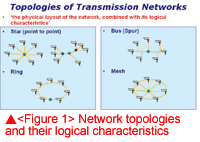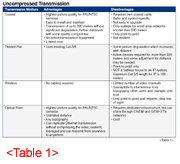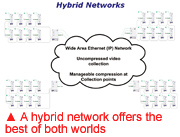In any integrated security and surveillance solution, transmission is often taken for granted. It is simply assumed that it provides relevant capacity to transmit video and audio data, and that it can handle expansions and integrate new technologies in the future. However, if the transmission is not designed correctly from the onset, making it right later on can be costly.
In any integrated security and surveillance solution, transmission is often taken for granted. It is simply assumed that it provides relevant capacity to transmit video and audio data, and that it can handle expansions and integrate new technologies in the future. However, if the transmission is not designed correctly from the onset, making it right later on can be costly.
Making sure that transmission is able to cope with system requirements now and in the future is not only key to a future-proof security and surveillance system, it also allows for easy and cost-effective expansions.
There are, however, many transmission technologies and media available; hence, deciding and designing the appropriate solution is not necessarily straightforward.
This article highlights the advantages and disadvantages of different technologies and designs and will, hopefully, provide some guidance in terms of how one can avoid some of the usual integration and configuration bottlenecks.
With a completely new project with no legacy technology involved, the first thing you have to consider is which signal format you plan to use — that is, compressed or uncompressed video signals.
If you start a network from scratch, this decision has major implications for the transmission network and medium(a) you design your network around.
Depending on the distances involved, choices for compressed video signals  include coaxial cables (Cat-5/6), optical fibers (multimode or singlemode, CWDM or DWDM), Ethernet, wireless transmission (unlicensed or licensed frequencies) or a mobile network.
include coaxial cables (Cat-5/6), optical fibers (multimode or singlemode, CWDM or DWDM), Ethernet, wireless transmission (unlicensed or licensed frequencies) or a mobile network.
If you need to transmit uncompressed video signals, media include coaxial, twisted pair, wireless and optical, depending on your requirements and distances.
The physical layout of the network — the topology — is often a function of the geographic distances and transmission medium(a). The topologies usually employed are star (also known as point-to-point), ring, bus (also know as spur) and mesh (a combination of star and ring. See <Figure 1>.
In many projects, however, there is either some legacy equipment involved in the  transmission. Or, there may be other specific requirements which necessitate the consideration of one more element, namely the mixture of signals on the network:
transmission. Or, there may be other specific requirements which necessitate the consideration of one more element, namely the mixture of signals on the network:
* Uncompressed, all analog: analog cameras and analog transmission
* Compressed, all IP: network cameras and IP transmission
* Hybrid: analog cameras, analog and IP transmission
* Mixed: analog and network cameras, analog and IP transmission
Uncompressed
In an ideal world, an uncompressed network would be preferable, as it affords the highest video quality for PAL/NTSC cameras and is well-understood for easy installation and maintenance.
You have a number of vendors you can choose from, although some solutions are considered proprietary. <Table 1> shows the advantages/disadvantages of the various media for uncompressed transmission.
Compressed
The main advantage in a compressed transmission network is that it allows video to fit into the global IP standard.
As HD cameras are beginning to gain traction, the technology will gradually offer  resolution benefits over uncompressed PAL/NTSC video. It is important to note, however, that a compressed solution can be limited in frame rate, can have issues with the temperature range it is operating in, and may have low-light performance issues.
resolution benefits over uncompressed PAL/NTSC video. It is important to note, however, that a compressed solution can be limited in frame rate, can have issues with the temperature range it is operating in, and may have low-light performance issues.
On the other hand, a compressed solution can use existing network infrastructure, such as Ethernet. Another thing to take into consideration is that historically compressed solutions have been troubled by algorithm obsolescence and vendor-dependent algorithm implementation. Further, there are trade-off issues with quality, latency and bandwidth.
Now, we are seeing more multivendor protocols emerging, requiring IT skills to install, commission and maintain networks. <Table 2> shows the advantages/ disadvantages of the various media for compressed transmission.
Hybrid Networks
A hybrid solution employs analog cameras with analog transmission to a control point/room where you then apply video compression. An IP network is used to link  the control points together. One could argue that a hybrid solution offers the best of both worlds. It gives you the largest choice of high-resolution cameras while retaining a high degree of security integrity because it keeps IP away from the edge of the network.
the control points together. One could argue that a hybrid solution offers the best of both worlds. It gives you the largest choice of high-resolution cameras while retaining a high degree of security integrity because it keeps IP away from the edge of the network.
It allows for easy upgrades of compression equipment while retaining the benefits associated with analytic software, which you do not have to install at the edge of the network, providing you with the highest quality signals available for content analysis. You have the flexibility to install analytics on any camera in a controlled environment, even deploying different software on different cameras for easy upgrades. Best of all, you can work with a multivendor system.
Mixed Networks
Mixed networks tend to be legacy-based, and they allow you to mix HD compressed cameras with PAL/NTSC uncompressed cameras. This caters for the application of centralized analytics on PAL/NTSC cameras and allows you to choose the best-of-breed technology for each location need. It further allows you to build a multivendor system.
How to Decide?
Start by considering all the technologies and topologies available to make sure you design a network based on the requirements of your given project. Many users  are not aware that the requirement specification is actually not a technology specification. You need to make informed decisions with respect to picture quality, maintainability, resilience, cost, security and future requirements.
are not aware that the requirement specification is actually not a technology specification. You need to make informed decisions with respect to picture quality, maintainability, resilience, cost, security and future requirements.
Only when you have considered these elements can you effectively decide the technology best suited for your particular project. In terms of topology, a point-to-point system may require the lowest initial equipment cost, but may be expensive in terms of maintainability, resilience, scalability or manageability. The more significant the requirement is in terms of security, the more up time and resilience matter in the transmission topology selected.
About the Author
Alan Hayes, founder and MD of AMG Systems, can be reached at alan.hayes@amgsystems.com.